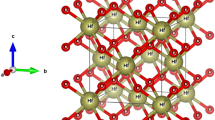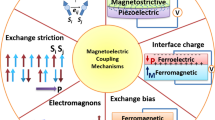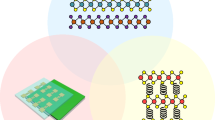abstract
Interfaces often exhibit unique electronic and magnetic properties that are not present in their bulk constituents. Understanding the atomic-level structure and properties of the interface is crucial for their technological applications. In this article, we report a first-principles study of the γ-FeSi2/Si(001) interface to unravel the atomic-level structure property relationship. An external electric field is included in our model to tune the properties of the interface. Based on our calculations, we found a modest application of an electric field (> 0.15 eV/Å) could stabilize a sixfold and sevenfold coordinated, spin-active interface over a nonmagnetic (eightfold coordinated) interface-providing direct evidence of electric field control of magnetism at the interface. The sixfold as well as sevenfold coordinated structures are shown to favor antiferromagnetic spin ordering arising from the Fe(d)-Si(p)-Fe(d) super-exchange interaction. The distinct non-linear response of the interface structure to the applied electric field can be attributed to the different electronic and magnetic structures at the interface; the sixfold exhibits the highest polarizability over the other coordinated structures.
Graphical abstract








Similar content being viewed by others
References
Goldfarb I, Cesura F, Dascalu M (2018) Magnetic binary silicide nanostructures. Adv Mater 30:1800004–1800014
Wu H, Kratzer P, Scheffler M (2005) First-principles study of thin magnetic transition-metal silicide films on Si(001). Phys Rev B 72:144425–144436
Kratzer P, Hashemifar SJ, Wu H, Hortamani M, Scheffler M (2007) Transition-metal silicides as materials for magnet-semiconductor heterostructures. J Appl Phys 101:081725–081729
Kikitsu A (2009) Prospects for bit patterned media for high-density magnetic recording. J Magn Magn Mater 321:526–530
Hellman F, Hoffmann A, Tserkovnyak Y, Beach GSD, Fullerton EE, Leighton C, MacDonald AH, Ralph DC, Arena DA, Dürr HA, Fischer P, Grollier J, Heremans JP, Jungwirth T, Kimel AV, Koopmans B, Krivorotov IN, May SJ, Petford-Long AK, Rondinelli JM, Samarth N, Schuller IK, Slavin AN, Stiles MD, Tchernyshyov O, Thiaville A, Zink BL (2017) Interface-induced phenomena in magnetism. Rev Mod Phys 89:025006–025084
Volokh M, Mokari T (2020) Metal/semiconductor interfaces in nanoscale objects: synthesis, emerging properties and applications of hybrid nanostructures. Nanoscale Adv 2:930–961
Acosta M, Baiutti F, Tarancón A, MacManus-Driscoll JL (2019) Nanostructured materials and interfaces for advanced ionic electronic conducting oxides. Adv Mater Interfaces 6:1900462–1900476
Hansson J, Nilsson TMJ, Ye L, Liu J (2018) Novel nanostructured thermal interface materials: a review. Int Mater Rev 63:22–45
Kalia RK, Vashishta P, Mahanti SD (1982) Orientational order-disorder transition on a surface. Phys Rev Lett 49:676–680
Leslie-Pelecky DL, Rieke RD (1996) Magnetic properties of nanostructured materials. Chem Mater 8:1770–1783
Tripathi JK, Markovich G, Goldfarb I (2013) Self-ordered magnetic α-FeSi2 nano-stripes on Si(111). Appl Phys Lett 102:251604–251608
Cao G, Singh DJ, Zhang XG, Samolyuk G, Qiao L, Parish C, Jin K, Zhang Y, Guo H, Tang S, Wang W, Yi J, Cantoni C, Siemons W, Payzant EA, Biegalski M, Ward TZ, Mandrus D, Stocks GM, Gai Z (2015) Ferromagnetism and nonmetallic transport of thin-film alpha-FeSi2: a stabilized metastable material. Phys Rev Lett 114:147202–147207
Zhandun VS, Zamkova NG, Ovchinnikov SG, Sandalov IS (2017) Self-consistent mapping: effect of local environment on formation of magnetic moment in alpha-FeSi2. Phys Rev B 95:054429–054442
Christensen NE (1990) Electronic structure of beta-FeSi2. Phys Rev B 42:7148–7153
Dascalu M, Diéguez O, Geng LD, Pati R, Jin YM, Goldfarb I (2019) Tomographic layer-by-layer analysis of epitaxial iron-silicide nanostructures by DFT-assisted STS. Appl Surf Sci 496:143583–143592
Chen YY, Lee PC, Tsai CB, Neeleshwar S, Wang CR, Ho JC, Hamdeh HH (2007) Chemical disorder-induced magnetism in FeSi2 nanoparticles. Appl Phys Lett 91:251907–251909
Hamdeh HH, Eltabey MM, Ho JC, Lee PC, Chen K, Chen YY (2010) Magnetism in nanoparticles of semiconducting FeSi2. J Magn Magn Mater 322:2227–2230
Goldfarb I, Camus Y, Dascalu M, Cesura F, Chalasani R, Kohn A (2017) Tuning magnetic response of epitaxial iron-silicide nanoislands by controlled self-assembled growth. Phys Rev B 96:045415–045425
Liang S, Islam R, Smith DJ, Bennett PA, O’Brien JR, Taylor B (2006) Magnetic iron silicide nanowires on Si(110). Appl Phys Lett 88:113111–113113
Gomoyunova MV, Malygin DE, Pronin II, Voronchikhin AS, Vyalikh DV, Molodtsov SL (2007) Initial stages of iron silicide formation on the Si(100) 2 × 1 surface. Surf Sci 601:5069–5076
Wallart X, Nys JP, Tételin C (1994) Growth of ultrathin iron silicide films: observation of the gamma-FeSi2 phase by electron spectroscopies. Phys Rev B 49:5714–5717
Onda N, Henz J, Müller E, Mäder KA, von Känel H (1992) Epitaxy of fluorite-structure silicides: metastable cubic FeSi2 on Si(111). Appl Surf Sci 56–58:421–426
Falke U, Bleloch A, Falke M, Teichert S (2004) atomic structure of a 2 × 1 reconstructed NiSi2/Si(001) interface. Phys Rev Lett 92:116103
Falke M, Falke U, Bleloch A, Teichert S, Beddies G, Hinneberg H-J (2005) Real structure of the CoSi2/Si(001) interface studied by dedicated aberration-corrected scanning transmission electron microscopy. Appl Phys Lett 86:203103–203105
Falke M, Falke U, Bleloch A (2006) Misfit dislocations at the CoSi2/Si(001) interface studied by aberration-corrected high angle annular darkfield imaging. J Phys Conf Ser 26:21–24
Mi SB, Jia CL, Zhao QT, Mantl S, Urban K (2009) NiSi2/Si interface chemistry and epitaxial growth mode. Acta Mater 57:232–236
Loretto D, Gibson JM, Yalisove SM (1989) Evidence for a dimer reconstruction at a metal-silicon interface. Phys Rev Lett 63:298–301
Bulle-Lieuwma CWT, de Jong AF, Vandenhoudt DEW (1991) Investigation of the atomic interface structure of mesotaxial Si/CoSi2(100) layers formed by high-dose implantation. Philos Mag A 64:255–280
Catana A, Schmid PE, Lu P, Smith DJ (1992) atomic structures at cobalt silicide-silicon interfaces. Philos Mag A 66:933–956
Chen W-J, Chen F-R (1993) The atomic structure of Σ = 1 and Σ = 3 NiSi2/Si interfaces. Philos Mag A 68:605–630
Mäder KA, von Känel H, Baldereschi A (1993) Electronic structure and bonding in epitaxially stabilized cubic iron silicides. Phys Rev B 48:4364–4372
Werner P, Jäger W, Schüppen A (1993) Interface structure and Schottky barrier height of buried CoSi2/Si(001) layers. J Appl Phys 74:3846–3854
Chisholm MF, Browning ND, Pennycook SJ, Jebasinski R, Mantl S (1994) Z-contrast investigation of the ordered atomic interface of CoSi2/Si(001) layers. Appl Phys Lett 64:3608–3610
Buschmann V, Fedina L, Rodewald M, Van Tendeloo G (1998) a new model for the (2 × 1) reconstructed CoSi2-Si(100) interface. Philos Mag Lett 77:147–152
Zhao FF, Feng YP, Dong YF, Zheng JZ (2006) Interface reconstruction of MSi2/Si(001) (M=Co, Ni) from first principles. Phys Rev B 74:033301–033304
Ong BL, Ong W, Foo YL, Pan J, Tok ES (2012) Growth dynamics of low-dimensional CoSi2 nanostructures revisited: influence of interface structure and growth temperature. Surf Sci 606:1649–1669
Ong BL, Ong SW, Tok ES (2016) Endotaxial growth of CoSi2 nanowires on Si(001) surface: the influence of surface reconstruction. Surf Sci 647:84–89
Yu BD, Miyamoto Y, Sugino O, Sakai A, Sasaki T, Ohno T (2001) Structural and electronic properties of metal-silicide/silicon interfaces: a first-principles study. J Vac Sci Technol B 19:1180–1185
Kresse G, Furthmüller J (1996a) Efficient iterative schemes for ab initio total-energy calculations using a plane-wave basis set. Phys Rev B 54:11169–11186
Kresse G, Hafner J (1993) ab initio molecular dynamics for liquid metals. Phys Rev B 47:558–561
Kresse G, Furthmüller J (1996b) Efficiency of ab-initio total energy calculations for metals and semiconductors using a plane-wave basis set. Comput Mater Sci 6:15–50
Kresse G, Hafner J (1994) ab initio molecular-dynamics simulation of the liquid-metal–amorphous-semiconductor transition in germanium. Phys Rev B 49:14251–14269
Blöchl PE (1994) Projector augmented-wave method. Phys Rev B 50:17953–17979
Kresse G, Joubert D (1999) From ultrasoft pseudopotentials to the projector augmented-wave method. Phys Rev B 59:1758–1775
Perdew JP, Burke K, Ernzerhof M (1996) Generalized gradient approximation made simple. Phys Rev Lett 77:3865–3868
Perdew JP, Burke K, Ernzerhof M (1997) Generalized gradient approximation made simple. Phys Rev Lett 78:1396–1396
Neugebauer J, Scheffler M (1992) adsorbate-substrate and adsorbate-adsorbate interactions of Na and K adlayers on al(111). Phys Rev B 46:16067–16080
Acknowledgements
The authors gratefully acknowledge Dr. Ilan Goldfarb and Dr. Oswaldo Diéguez for their valuable comments and suggestions on the manuscript.
Author information
Authors and Affiliations
Corresponding author
Ethics declarations
Conflict of interest
The authors declare that they have no conflict of interest.
Additional information
Handling Editor: Avinash Dongare.
Publisher's Note
Springer Nature remains neutral with regard to jurisdictional claims in published maps and institutional affiliations.
Rights and permissions
About this article
Cite this article
Geng, L.D., Pati, R. & Jin, Y.M. Electric field control of magnetism at the γ-FeSi2/Si(001) interface. J Mater Sci 56, 3804–3813 (2021). https://doi.org/10.1007/s10853-020-05500-x
Received:
Accepted:
Published:
Issue Date:
DOI: https://doi.org/10.1007/s10853-020-05500-x




